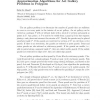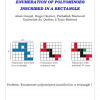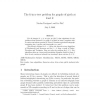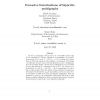DAM
2010
14 years 8 months ago
2010
DAM
2010
14 years 10 months ago
2010
An assignment of positive integer weights to the edges of a simple graph G is called irregular if the weighted degrees of the vertices are all different. The irregularity strength,...
100
Voted
DAM
2010
14 years 10 months ago
2010
112
click to vote
DAM
2010
14 years 11 months ago
2010
We consider the problem of sorting a permutation using a network of data structures as introduced by Knuth and Tarjan. In general the model as considered previously was restricted...
110
click to vote
DAM
2010
15 years 1 months ago
2010
A dynamic coloring of a graph is a proper coloring of its vertices such that every vertex of degree more than one has at least two neighbors with distinct colors. The least number...
DAM
2010
15 years 1 months ago
2010
107
click to vote
DAM
2010
15 years 1 months ago
2010
An equivalence graph is a disjoint union of cliques, and the equivalence number eq(G) of a graph G is the minimum number of equivalence subgraphs needed to cover the edges of G. W...
DAM
2010
15 years 1 months ago
2010
116
Voted
DAM
2010
15 years 1 months ago
2010
For all integers k 3, we give an O(n4 ) time algorithm for the problem whose instance is a graph G of girth at least k together with k vertices and whose question is "Does G...
DAM
2010
15 years 1 months ago
2010
Let G be a multigraph. We say that G is 1-extendable if every edge of G is contained in a 1-factor. Suppose G is 1-extendable. An excessive factorization of G is a set F = {F1, F2...




